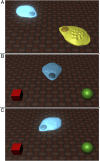Variability of signal sequences in turn-taking exchanges induces agency attribution in 10.5-mo-olds
- PMID: 31308230
- PMCID: PMC6681728
- DOI: 10.1073/pnas.1816709116
Variability of signal sequences in turn-taking exchanges induces agency attribution in 10.5-mo-olds
Abstract
Infants' sensitivity to contingent reactivity as an indicator of intentional agency has been demonstrated by numerous referential gaze-following studies. Here we propose that variability of signal sequences in a turn-taking exchange provides an informative cue for infants to recognize interactions that may involve communicative information transfer between agents. Our experiment demonstrates that based on the abstract structural cue of variability of exchanged signal sequences, 10.5-mo-olds gaze-followed an entity's subsequent object-orienting action to fixate the same object. This gaze-following effect did not depend on the specific acoustic features of the sound signals produced. However, no orientation following to target was induced when the exchanged signal sequences were identical, or when only a single entity produced the variable sound sequences. These results demonstrate infants' early sensitivity to detect signal variability in turn-taking interactions as a relevant feature of communicative information transfer, which induces them to attribute intentional agency and communicative abilities to the participating entities. However, when no variability was present in the exchanged signals, or when the variable signal sequences were produced by a single entity alone, infants showed no evidence of attributing agency. In sum, we argue that perceiving contingent turn-taking exchange of variable signal sequences induce 10.5-mo-old preverbal infants to recognize such interactions as potentially involving communicative information transmission and attribute agency to the participating entities even if both the entities and the signals they produce are unfamiliar to them.
Keywords: agency; communication; gaze following; infant; turn taking.
Conflict of interest statement
The authors declare no conflict of interest.
Figures


References
-
- Sperber D., Wilson D., Relevance: Communication and Cognition (Blackwell’s, Oxford, 1986).
-
- Sperber D., Wilson D., Pragmatics, modularity and mind-reading. Mind Lang. 17, 3–23 (2002).
-
- Gergely G., Jacob P., “Reasoning about instrumental and communicative agency in human infancy” in Rational Constructivism in Cognitive Development, Xu F., Kushnir T., Eds. (Academic Press, Cambridge, MA, 2012), pp. 59–94. - PubMed
-
- Tomasello M., Why We Cooperate (MIT Press, Cambridge, MA, 2009).
Publication types
MeSH terms
LinkOut - more resources
Full Text Sources

